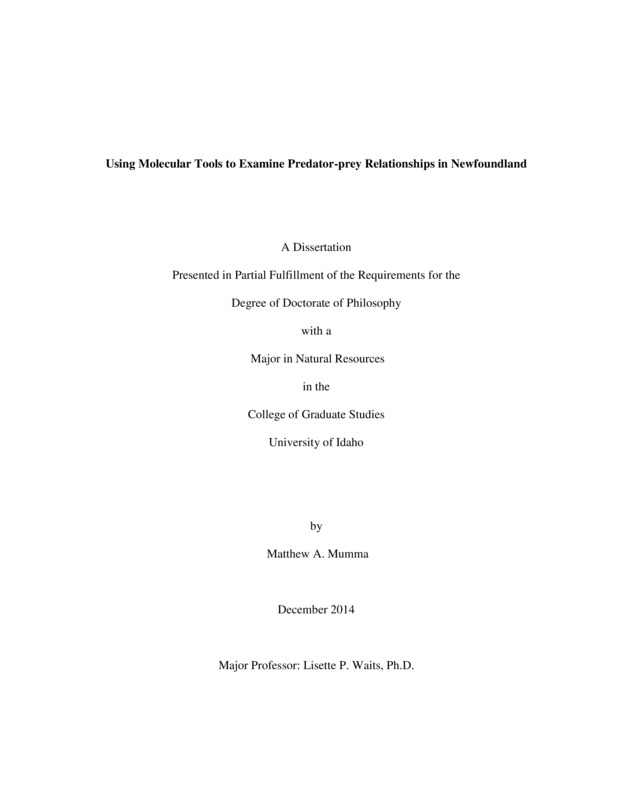Using Molecular Tools to Evaluate Predator-Prey Relationships in Newfoundland
Mumma, Matthew Allen. (2014). Using Molecular Tools to Evaluate Predator-Prey Relationships in Newfoundland. Theses and Dissertations Collection, University of Idaho Library Digital Collections. https://www.lib.uidaho.edu/digital/etd/items/mumma_idaho_0089e_10471.html
- Title:
- Using Molecular Tools to Evaluate Predator-Prey Relationships in Newfoundland
- Author:
- Mumma, Matthew Allen
- Date:
- 2014
- Keywords:
- black bear caribou coyote molecular predation
- Program:
- Natural Resources
- Subject Category:
- Ecology; Wildlife management; Wildlife conservation
- Abstract:
-
Predation is a central process in many ecological communities, but the relationships between predator and prey populations are highly variable as a result of the inherent complexity of predator-prey systems. In recent years, the use of molecular methods in ecology has rapidly increased, but the application of molecular tools in the study of predation remains underutilized. We were interested in using molecular tools to illuminate the interactions between two predators and a common prey species, caribou, in Newfoundland. We compared morphological and molecular methods of food habit analyses and used noninvasive sampling to estimate black bear and coyote abundances. We also utilized molecular tools and a statistical model to decrease the subjectivity associated with predator species identification at kill sites. Our research suggested that molecular methods detect prey species in a significantly higher percentage of predator scats. Although caribou were frequently detected in black bear and coyote scats, we determined that moose were the most common prey species for both predators. We also demonstrated that black bears and coyotes were the primary predators of caribou calves, and that predation by Canada lynx, red fox, and bald eagle was limited. In addition, our approach elucidated predator-specific kill site observations that should improve the accuracy of future predator species identifications at calf kills. We also found that the most cost-effective and efficient methods of sampling predator populations for the purpose of abundance estimation may vary between species and across study sites. Our study demonstrated that molecular tools can be expanded to illuminate complex predator-prey processes and inform conservation and management decisions.
- Description:
- doctoral, Ph.D., Natural Resources -- University of Idaho - College of Graduate Studies, 2014
- Major Professor:
- Waits, Lisette P
- Committee:
- Horne, Jon; Rachlow, Janet; Murray, Dennis
- Defense Date:
- 2014
- Identifier:
- Mumma_idaho_0089E_10471
- Type:
- Text
- Format Original:
- Format:
- application/pdf
- Rights:
- In Copyright - Educational Use Permitted. For more information, please contact University of Idaho Library Special Collections and Archives Department at libspec@uidaho.edu.
- Standardized Rights:
- http://rightsstatements.org/vocab/InC-EDU/1.0/

